
Bird nests can look like many different things: scrapes in the soil, rocky ledges, and old woodpecker holes in dead trees. But what about those gigantic structures that rest on magnificently tall trees? Or elaborate huts that look like their straight out of Architectural Digest? Discover nine birds that build the largest nests, including the nest’s size and location.
Bald Eagle
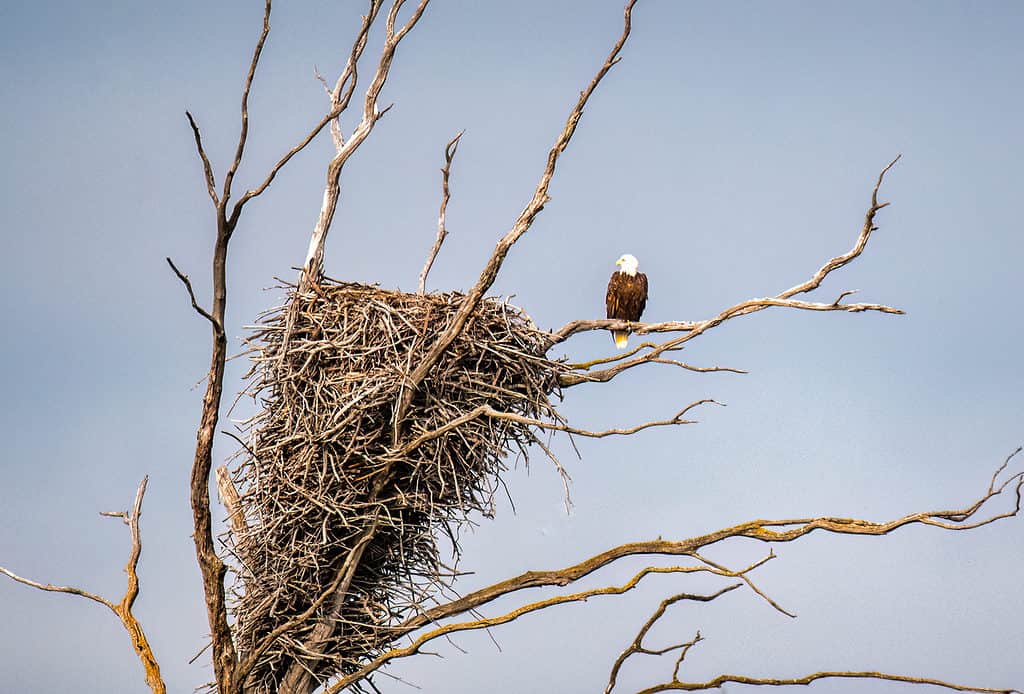
The largest bald eagle nest on record was 9 feet wide, 20 feet deep, and weighed over 4,400 pounds! Eagle pairs reuse the same nest for decades, adding new material every breeding season.
©iStock.com/Tammi Mild
Bald eagles are enormous, powerful birds of prey native to North America. They are known for their considerable wingspans, reaching up to seven feet. But they are also famous for their gigantic nests. The largest bald eagle nest on record was near St. Petersburg, Florida. It measured over nine feet wide, 20 feet deep, and weighed over 4,400 pounds! Another in Ohio was used by a pair for 34 years and weighed over two tons. Their nests are huge because eagle pairs reuse the same nest for decades, adding new material every breeding season. They construct them using large sticks and then line the inside with moss, grass, seaweed, and other plant material. The average bald eagle’s nest is six feet wide and three feet deep.
Sociable Weaver
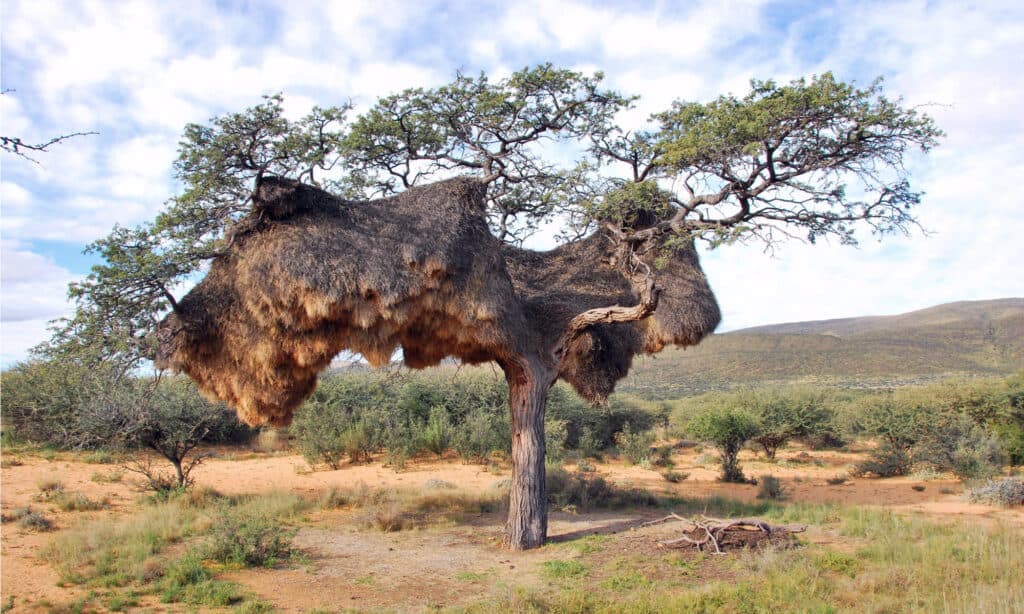
Their nests look like giant haystacks. The underside has circular openings leading into inner chambers. The structure can measure 23 feet wide.
©Michael Potter11/Shutterstock.com
Many believe the largest bird nest is up for debate. And you might too after hearing about the sociable weaver. Bald eagles build big nests because they are big birds. But sociable weavers are relatively small in the bird world. However, what they lack in size, they make up for in teamwork. These sparrow-sized birds weave one giant nest for their entire colony, containing up to 100 families and lasting over 100 years! At first glance, the nest resembles a large haystack perched on naked branches. But upon further examination, you can spot many circular holes on the underside of the structure. These openings lead into an inner chamber where all the birds live communally. They weave their nests using straw and line the inside with cotton and feathers. They can measure up to 23 feet in diameter, with each chamber four to six inches wide.
Golden Eagle
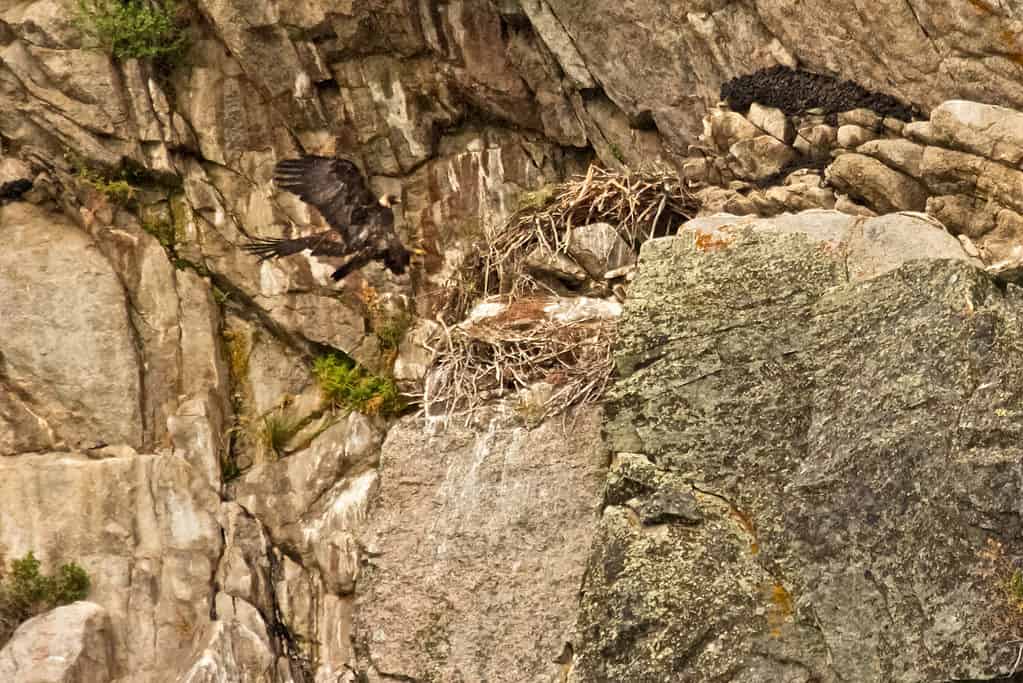
Golden eagle nests can reach 20 feet tall and nine feet wide. They place their platform on cliffs or other inaccessible places.
©iStock.com/Jack R Perry
Golden eagles are exceptional creatures. They are one of the fastest, largest, most agile birds in the world, with a wingspan reaching close to eight feet. So it’s no surprise that such a large, majestic bird would need an equally impressive nest. On average, their nests are six feet wide and two feet high, but they can get much larger. The biggest golden eagle nest on record was 20 feet tall and almost nine feet wide. Couples place their platform structures on cliffs or other inaccessible places and construct them using coarse branches and lining the inside with grass, lichen, thin twigs, and moss.
Orange-Footed Scrub Fowl
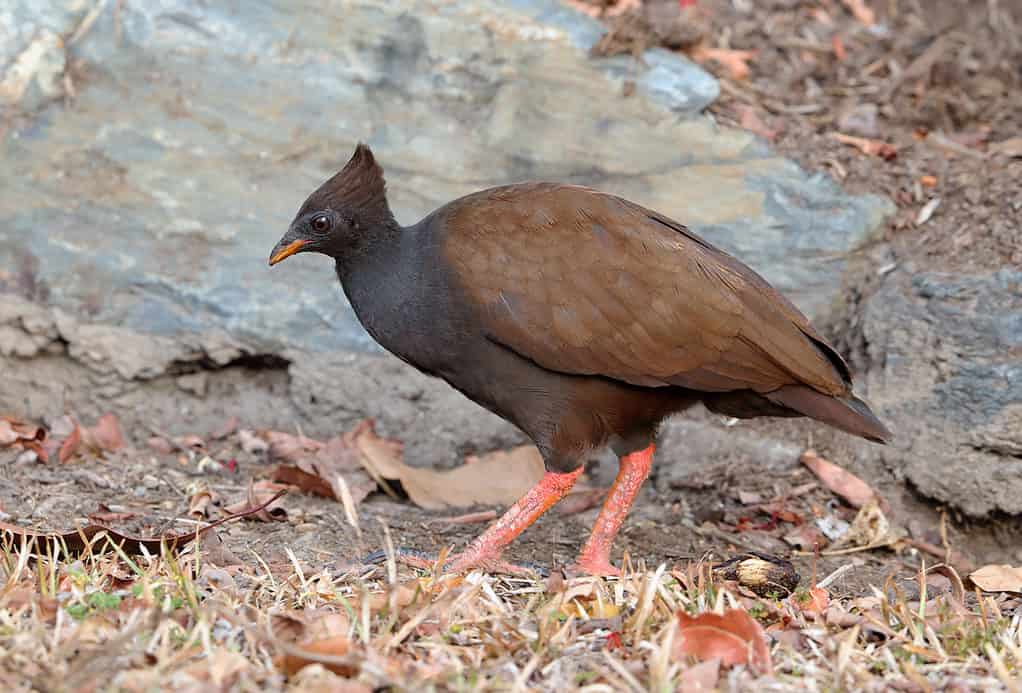
Orange-footed scrub fowls build impressive incubator mounds using dead leaves, soil, and sand.
©iStock.com/AGAMI Stock
The orange-footed scrubfowl is a medium-sized ground-dwelling bird native to Australia. And they’ve gained notoriety for building impressive incubator mounds consisting of dead leaves, soil, and sand. The decomposition of organic material within the mound generates heat and successfully incubates their eggs. Construction of the nests takes place throughout the year, and the final product can reach 15 feet high and 30 feet in diameter! Human residents within the orange-footed scrubfowl range may be displeased when these birds begin scratching up their garden, looking for the perfect mound site.
Bowerbird
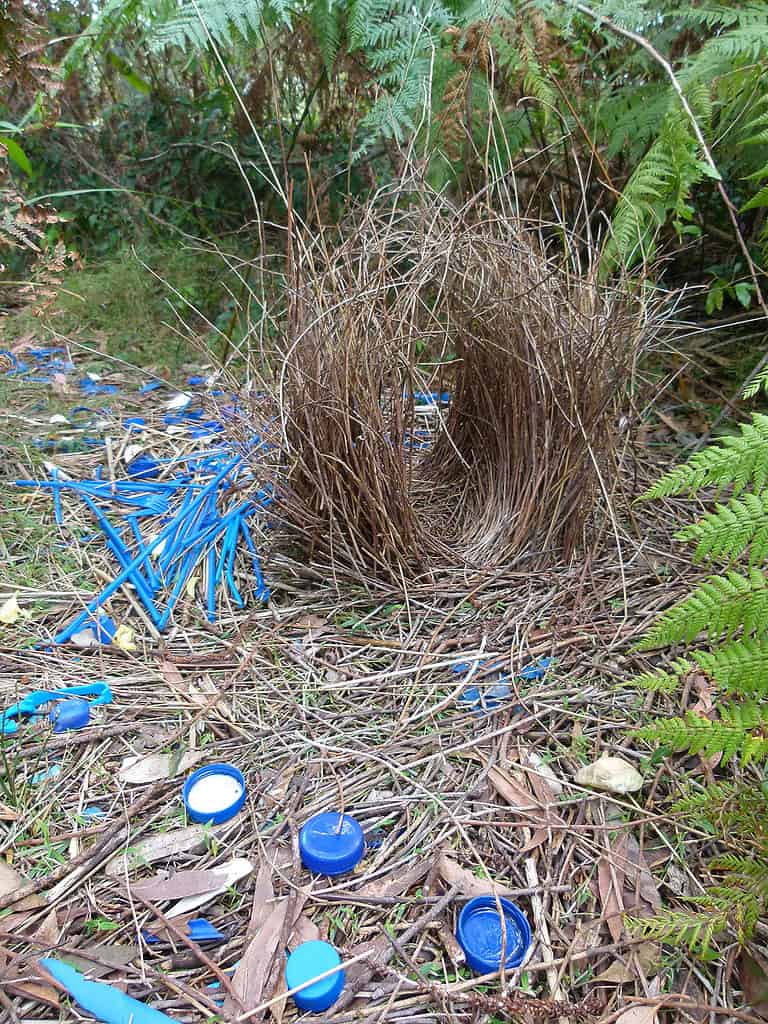
Bowerbirds create elaborate hut-like structures decorated with brightly colored objects, chosen based on the female’s preference.
©iStock.com/skeat
The bowerbird is a unique species known for its courtship behavior. These large passerines endemic to Australia have a very traditional approach to mating. The males create elaborate hut structures, which they decorate with brightly-colored objects, such as shells, flowers, and stones. They arrange their collection in piles, and the colors chosen are often picked based on the female’s preference. Females will visit the huts of multiple males before making their decision. Sometimes one male (the best decorator) will have several offers. These hut-like structures can reach over five feet high and six feet in diameter.
Stork
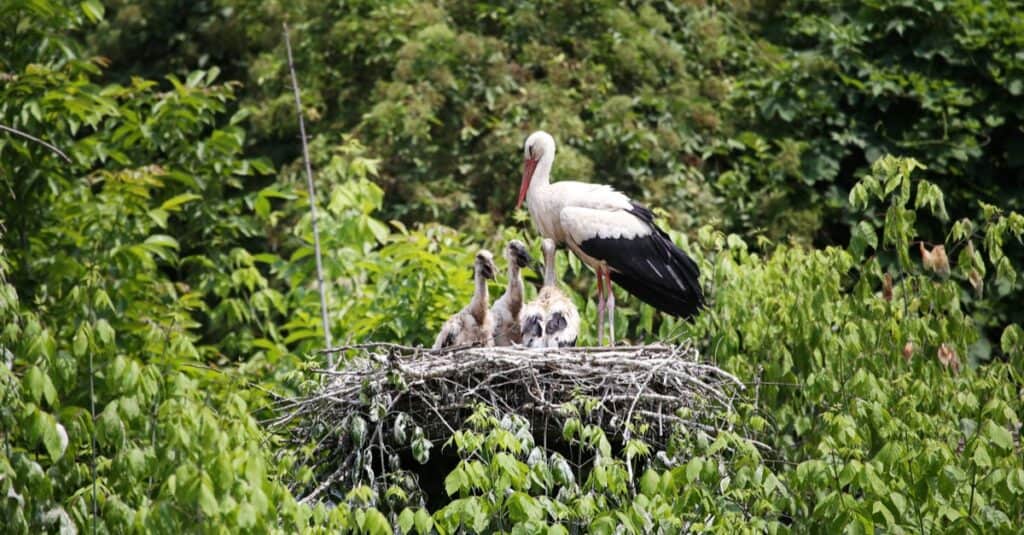
Stork nests are enormous platform structures made of twigs and grass, measuring more than 9 feet deep and 6 feet wide.
©MikeDotta/Shutterstock.com
Storks are heavy-wading birds with long necks, long legs, and long bills. Storks are docile creatures, typically synonymous with new life, specifically the welcoming of a newborn. So it’s fitting that they would also be known for their impressive nests, where they welcome their own new life. Stork nests are enormous platform structures made of twigs and grass, measuring more than nine feet deep and six feet wide. They are so large that other smaller birds, like starlings and sparrows, make their nests in the spaces between the sticks.
Harpy Eagle

Harpy eagles reuse the same nest for many years and are large enough for a human to lie across. The average nest is 4 feet high and 5 feet across.
©iStock.com/Seckin Ozturk
The harpy eagle is a magnificent creature with bold and elegant features. They are around the size of a human child and feature seven-foot wingspans and huge talons. And their nests are certainly a reflection of their giant stature. Harpy eagles reuse the same nest for many years and are large enough for a human to lie across. The average nest size is four feet high and five feet across. It consists of sticks and branches, which they gather from nearby trees. And females line the interior with fur and soft plant material.
Osprey
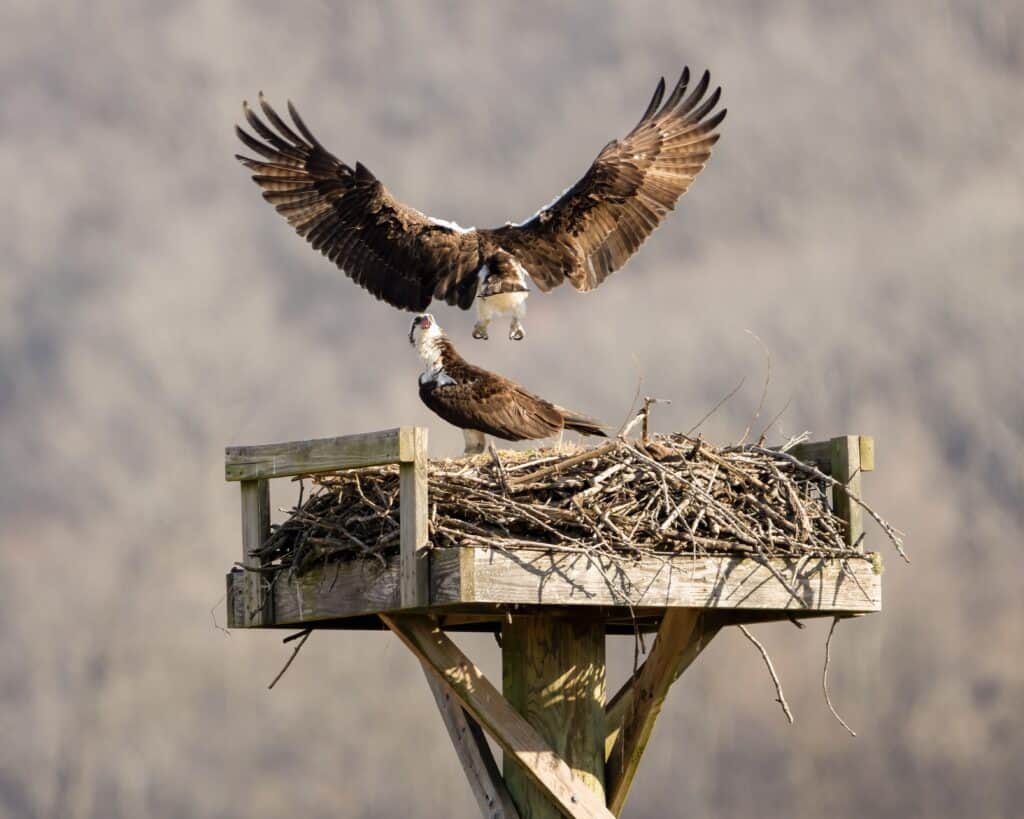
Ospreys breed near freshwater lakes and rivers and place their nests in tree forks, rocky outcrops, or artificial structures.
©Wirestock Creators/Shutterstock.com
Ospreys are large sea hawks with a cosmopolitan range. Like many on this list, the osprey is a raptor with a sprawling wingspan reaching six feet. They breed near freshwater lakes and rivers and place their nests in tree forks, rocky outcrops, or artificial structures. The nest is made from sticks, driftwood, and seaweed, and many are reused each season, some lasting over 70 years. Sometimes it takes several years for the nest to become noteworthy but can eventually reach 13 feet deep and six feet in diameter. So if you ever wanted to sit in a bird’s nest, well, you can!
Trumpeter Swan
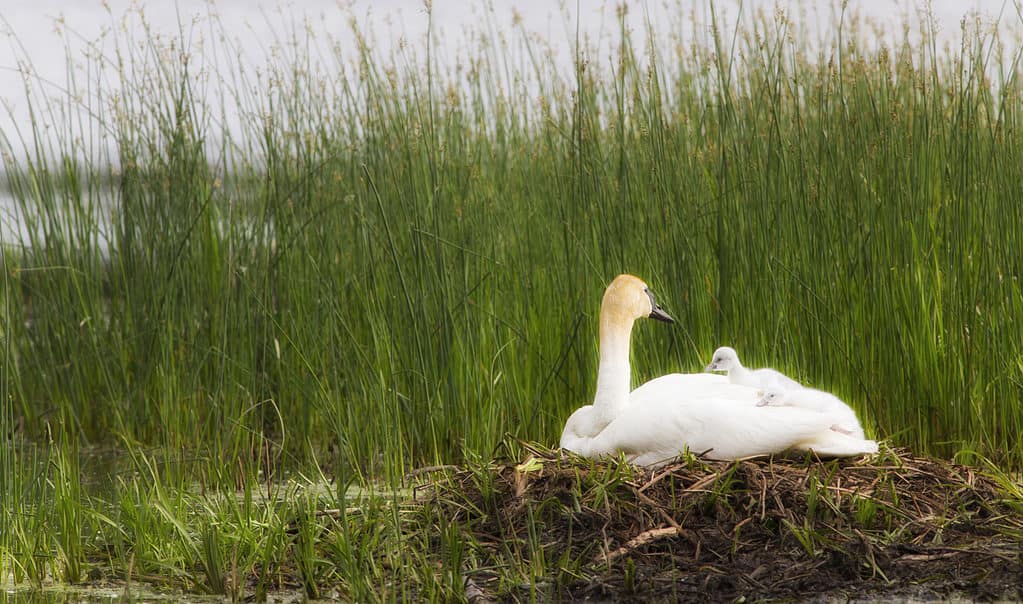
Trumpeter swans use aquatic vegetation to shape a mound with a bowl-shaped structure. It can reach 11 feet across and 3 feet high.
©iStock.com/JackVandenHeuvel
Trumpeter swans are the biggest native waterfowl in North America, stretching six feet long and weighing over 25 pounds. They breed in remote Alaskan wetlands and place their nests in areas surrounded by water, such as beaver dens and floating vegetation mats. They use aquatic vegetation to shape the nest into a mound with a bowl-shaped structure on top. Once completed, the mound can reach 11 feet across and 3 feet high.
Honorable Mention—Other Remarkable Bird Nests
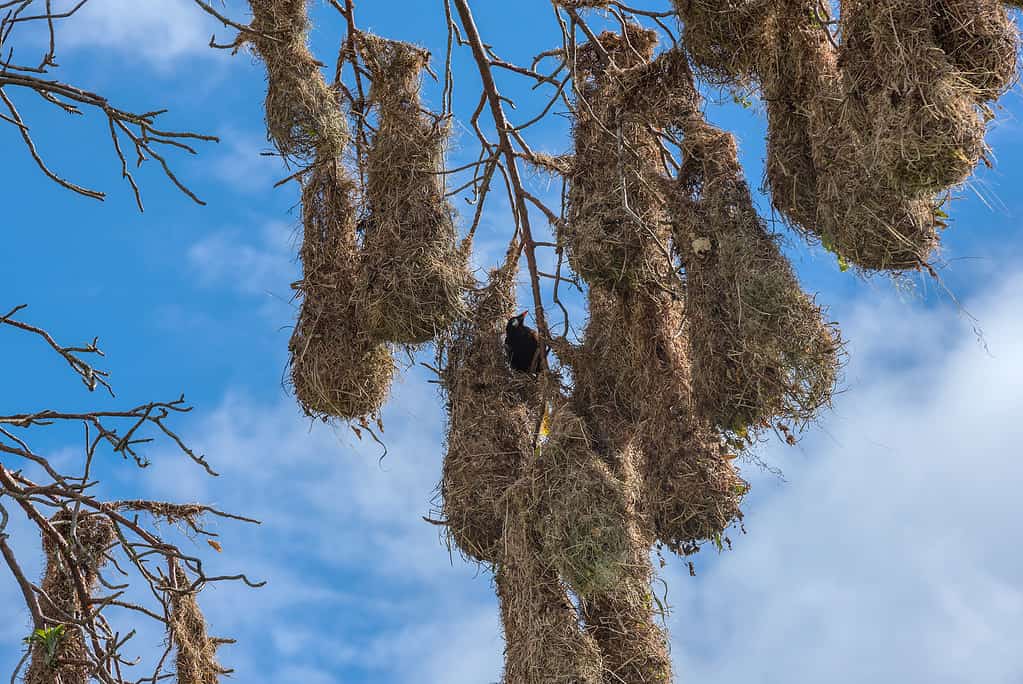
The nests of the Montezuma oropendola bird (Psarocolius montezuma) in Costa Rica are incredible.
©Rainer Lesniewski/iStock via Getty Images
Montezuma Oreopendola Nests
Psarocolius montezuma, also known as Montezuma oropendolas, are tropical birds found in the Caribbean coastal lowlands. They form colonies and weave nests from fibers and vines hanging from trees. The nests can be up to 6 feet long, and there can be up to 150 nests in each colony. To deter potential predators, they often build near wasps’ nests. In each colony, a dominant male will mate with most of the females, while some of the subordinate males are able to mate away from the main colony.
Eurasian Penduline Tit Nests
The Eurasian penduline tit is the only member of its family to be found outside Africa. This bird is renowned for its expert nest-building abilities, with the male beginning the structure of the pouch-shaped nest using plant fibers and fluffy seeds on willow or birch trees – a task that the female will help him complete. These nests are so strong that they have even been used as purses by the Masai people and as shoes for children in Europe.
Edible-Nest Swiftlet Nests
Edible-nest swiftlets are small birds that live in Southeast Asia and build their nests out of an unusual material—their own spit! These nests can fetch a high price in the market, with an average nest selling for around $2,500 USD. The nests are built in colonies on the faces of cliffs, caves, or even buildings and are composed of layers of hardened saliva. They have a white, translucent appearance and contain a variety of minerals, such as calcium, magnesium, and iron.
What is the Largest Birds Nest in the Australia?

If you are in Australia, be sure to check out the industrious malleefowl nests.
©AGAMI stock/iStock via Getty Images
Malleefowl (Leipoa ocellata) are a species of ground-dwelling bird native to Australia. It is medium-sized, typically 17-20 inches in length and weighing 2-4 pounds. Their plumage is brownish-gray in color, with black and white mottling on the wings and tail. The Malleefowl has distinctive red facial wattles and blue-gray eye patches.
The mallee fowl is a ground-dweller living in open woodlands and scrublands. It tends to make its nest in an open mound of soil and organic material, which it builds up over many years. The mounds are an average of 12 feet in height. The female lays her eggs in the mound, which the male then incubates.
The largest mallee fowl nest ever recorded was discovered in Australia. It stood 15 feet tall and spanned 35 feet across, requiring 8,793 cubic feet of material. It weighed an incredible 300 tons. That is 661,386 pounds! These birds used meticulous precision to construct it. Not only does it provide shelter and protection for eggs and hatchlings against predators and environmental factors, but it plays a crucial role in nutrient recycling. It is fascinating to contemplate how nature has evolved creatures capable of such monumental structures.
Summary Of 9 Birds That Build The Largest Nests
Let’s take a second look at the 9 largest nest-building birds in the world.
| Rank | Bird That Build Largest Nest |
|---|---|
| 1 | Bald Eagle |
| 2 | Sociable Weaver |
| 3 | Golden Eagle |
| 4 | Orange-Footed Scrub Fowl |
| 5 | Bowerbird |
| 6 | Stork |
| 7 | Harpy Eagle |
| 8 | Osprey |
| 9 | Trumpeter Swan |
The photo featured at the top of this post is © iStock.com/June Jacobsen
Thank you for reading! Have some feedback for us? Contact the AZ Animals editorial team.






